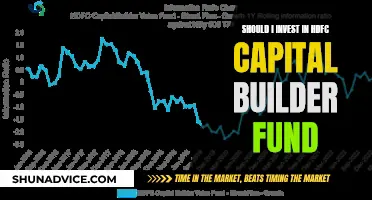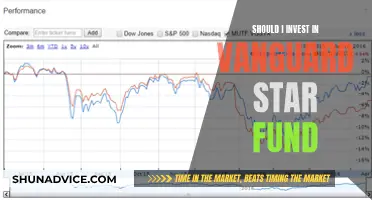
Investing in funds is a great way to build wealth, but it's important to understand the pros and cons of this approach. Mutual funds, for instance, pool money from multiple investors to invest in different securities, providing instant diversification. This diversification reduces risk and is a key advantage of mutual funds over individual stock-picking. Mutual funds are also convenient, as they are managed by professionals, and often have lower costs due to economies of scale. However, investors give up some control to fund managers and may prefer to manage their own portfolios directly. Index funds, which aim to replicate a preset basket of stocks or an index like the S&P 500, are another type of investment fund that offers broad diversification and lower costs. While investing in funds can be a compelling strategy, it's important to conduct thorough research and consider factors like fees, investment goals, and risk tolerance before making any investment decisions.
| Characteristics | Values |
|---|---|
| Risk | All investments carry some degree of risk. The reward for taking on risk is the potential for a greater investment return. |
| Diversification | Mutual funds offer instant diversification. An index fund usually owns dozens of securities and may own hundreds, meaning that it's highly diversified. |
| Cost | Index funds can be very low cost, with a low expense ratio. For larger funds, you may pay $3 to $10 per year for every $10,000 invested. |
| Returns | Index funds promise solid returns over time, such as the S&P 500’s long-term record of about 10% annually. |
| Control | Mutual funds require that you give up some control to a fund manager. |
| Effort | Mutual funds require less work and are more hands-off. You can buy them and barely monitor your investment portfolio. |
| Taxes | Mutual funds are less tax-efficient than ETFs. At the end of the year, many mutual funds pay a taxable capital gains distribution, while ETFs do not. |
| Fees | Mutual funds have ongoing management fees, which can be very low if the fund is passively managed and higher if it is actively managed. |

Mutual funds vs. stocks
Mutual funds are investment vehicles that pool money from multiple investors to buy a diversified portfolio. Stocks, on the other hand, represent ownership in a specific company, and their value fluctuates based on the company's performance and market conditions.
When you invest in a mutual fund, you're buying shares in a fund that invests in multiple securities, such as money market instruments, bonds, or stocks. When you invest in stocks, you're purchasing shares of a single company.
Mutual funds offer instant diversification, reducing the risk of losing money. They are also managed by professionals, reducing the need for monitoring. Additionally, mutual funds can be low-cost, especially passively managed index funds, and they provide exposure to a multitude of stocks.
Mutual funds may have minimum investment rules and require the fund to be held for a certain amount of time before cashing out. They also charge management fees, which can be high for actively managed funds. While mutual funds reduce risk, they also limit potential gains when compared to stocks.
Stocks offer higher returns than mutual funds and give you control over which companies you invest in. If a stock performs well, you'll reap all the benefits of that increase.
Stocks come with higher risk and volatility. It can be time-consuming to monitor individual stocks, and you may be charged a brokerage fee every time you buy or sell.
The choice between mutual funds and stocks depends on your goals, time horizon, and risk tolerance. Mutual funds are generally a good option for those seeking a long-term, diversified investment strategy, while stocks are better for those seeking higher returns and are comfortable with more risk.
Bond Funds: Best Time to Invest and Why
You may want to see also

Index funds
- Lower fees: Index funds typically have lower expense ratios than actively managed funds since they are passively managed.
- Market representation: Index funds aim to mirror the performance of a specific index, offering broad market exposure and diversification.
- Transparency: The holdings of an index fund are well-known and available on most investing platforms.
- Historical performance: Over the long term, many index funds have outperformed actively managed funds, especially after accounting for fees and expenses.
- Tax efficiency: Lower turnover rates in index funds usually result in fewer capital gains distributions, making them more tax-efficient.
When choosing an index fund, it's important to consider factors such as long-run performance, expense ratios, trading costs, and fund options. It's also crucial to understand the differences between index mutual funds and index ETFs in terms of liquidity, fees, and trading strategies.
- Fidelity ZERO Large Cap Index
- Vanguard S&P 500 ETF
- SPDR S&P 500 ETF Trust
- IShares Core S&P 500 ETF
- Schwab S&P 500 Index Fund
- Shelton NASDAQ-100 Index Direct
- Invesco QQQ Trust ETF
- Vanguard Russell 2000 ETF
- Vanguard Total Stock Market ETF
- SPDR Dow Jones Industrial Average ETF Trust
A Guide to Investing Wisely in Mutual Funds
You may want to see also

Diversification
Benefits of Diversification
Reducing Risk
The primary goal of diversification is to reduce the impact of volatility on your portfolio. By investing in different types of assets, you lower the chances of all your investments being affected by the same market events. For example, stocks and bonds often move in opposite directions, so including both in your portfolio can help smoothen returns. Diversification also helps protect against losses, which is crucial for older investors and retirees who need to preserve their wealth.
When diversifying your portfolio, you can consider various strategies. One approach is to diversify across asset classes, such as stocks, bonds, cash, and alternative investments like real estate, commodities, or cryptocurrencies. You can also diversify across industries and sectors, as certain industries may be affected by unique factors. For instance, investing in both the technology and energy sectors can provide diversification as they are influenced by different market forces.
Geographic Diversification
In addition to diversifying across asset classes and industries, you can also spread your investments geographically. Investing in companies and entities headquartered in different countries can provide exposure to different currencies and economies, further reducing risk. For instance, investing in both U.S. and international stocks can help mitigate the impact of country-specific economic fluctuations.
Practical Tips for Diversification
- Asset Allocation: Divide your investments between stocks and bonds based on your age and risk tolerance. A common rule of thumb is to subtract your age from 100 to determine the percentage of stocks in your portfolio.
- Mutual Funds and ETFs: Utilise mutual funds and exchange-traded funds (ETFs) to gain exposure to different asset classes and a diverse range of underlying securities.
- Global Markets: Consider investing in global markets to access high-return opportunities and further diversify your portfolio.
- Rebalancing: Periodically review and rebalance your portfolio to ensure it aligns with your goals and risk tolerance.
In conclusion, diversification is a powerful tool for investors to manage risk and optimise returns. By spreading your investments across various assets, industries, and regions, you can reduce the impact of market volatility and improve the resilience of your portfolio.
Broker Benefits for Mutual Fund Investors
You may want to see also

Risk and return
The relationship between risk and return is often described as a trade-off, with higher levels of risk associated with higher potential returns. This is known as the risk-return tradeoff principle, which states that the potential return rises with an increase in risk. In other words, if an investor is willing to accept a higher possibility of losses, they can expect higher profits.
It is important to note that higher risk does not guarantee higher returns, but rather indicates the possibility of higher returns. The appropriate level of risk and return depends on various factors, including an investor's risk tolerance, time horizon, and ability to replace lost funds.
When assessing the risk and return of an investment, it is crucial to consider the different types of risk involved. Systematic risk, also known as market risk, affects the entire economic market or a large portion of it. This includes factors such as political risk, macroeconomic risk, interest rate risk, and inflation risk. Unsystematic risk, on the other hand, is specific to an industry or company and includes factors such as management changes, product recalls, or new competition.
Additionally, risk can be quantified using various metrics and strategies, such as standard deviation, beta, Value at Risk (VaR), and the Capital Asset Pricing Model (CAPM). Standard deviation, for example, measures the volatility of a value in comparison to its historical average, with a higher standard deviation indicating higher risk.
When investing in funds, it is important to remember that there is always some level of risk involved. The risk associated with mutual funds, for example, depends on the underlying risks of the stocks, bonds, and other investments held by the fund. No mutual fund can guarantee its returns or be completely risk-free.
To make informed investment decisions, individuals should carefully consider their financial goals, risk tolerance, and time horizon. Diversification is also a key strategy for managing risk, as it helps to reduce the impact of specific risks by spreading investments across different types of assets and industries.
Index Funds: A Smart Investment Strategy for Long-Term Wealth
You may want to see also

Costs
All investments carry costs, and these costs reduce any returns you might get on your investments. Common investing costs include expense ratios, market costs, custodian fees, advisory fees, commissions, and loads.
Mutual funds require investors to pay a small annual fee, or expense ratio, to hold onto their shares. This fee is taken off the value of each share. The expense ratio is a measure of what it costs to manage the fund, expressed as a percentage. It is based on the total assets invested in the fund and is calculated annually. This fee is typically paid out of fund assets, so you won't be billed for it, but it will come out of your returns. That means if the mutual fund returns 8% and the expense ratio is 1.5%, you've only really earned 6.5% on your shares.
Actively managed mutual funds have expense ratios that often range between 1% and 2%. Most of that fee pays for portfolio managers to make buy-and-sell decisions in an attempt to outperform the overall market.
Index funds, by contrast, are passively managed. They simply track an index by buying and holding all of the stocks in that index, so the holdings of the index fund rarely change. The expense ratios for index funds are typically much lower, ranging from 0.05% to 0.07%, and some have expense ratios as low as 0%.
In addition to expense ratios, there are several other fees to be aware of when investing in mutual funds. Annual fees are often low, about $25 to $90 a year, but every dollar adds up. Custodian fees usually apply to retirement accounts and cover costs associated with fulfilling IRS reporting regulations. You can expect to pay anywhere from $10 to $50 per year for these.
A front-end load is a fee charged when you buy shares, while a back-end load is a fee incurred when selling. Commissions are essentially fees that are paid to the broker for their services, and these usually range from $1 to $5 per trade.
It's important to do careful research and ask plenty of questions to protect yourself from excessive or unwarranted fees. Taking the time to understand what you're paying is critical because fees, over the long term, can rob investors of their wealth.
Some mutual funds also include purchase and redemption fees, which are a percentage of the amount you're buying or selling.
Fees almost always appear deceptively low. For example, an investor might see an expense ratio of 2% and dismiss it as inconsequential. But a fee expressed as a percentage doesn't reveal the actual dollar amount being paid, and more importantly, how those dollars will grow over time.
Just as compounding delivers growing returns to long-term investors, high fees do the opposite; a static cost rises exponentially over time. This is known as anchoring bias, where irrelevant information is used to evaluate something of unknown value.
For example, if you have an investment account worth $80,000 and you hold the investment for 25 years, earning 7% per year, you'll have approximately $386,000 if you're paying 0.50% in annual fees. But if you're paying 2.0% annually, you'll be left with only about $271,000. That "tiny" 2.0% cost you $115,000.
Brokerage fees come in many shapes and sizes. An account maintenance fee is usually an annual or monthly fee charged for the use of the brokerage firm and its research tools. This fee is occasionally tiered, so those who want to use more robust data and analytic tools pay more.
Some mutual funds include a load or a commission paid to the broker who sold you the fund. Be wary of these charges, as many mutual funds today are no-load and are therefore cheaper alternatives. Also, some brokers will push funds with larger loads to pad their revenue.
This type of fee is also sometimes referred to as a management fee for the expertise the broker brings to the table in the form of wealth strategies. This cost is a percentage of the total assets the investor has under the broker's management.
Commission fees are the cost of executing any buy or sell trade, and this payment goes directly to the broker. This usually ranges from $1 to $5 per trade and may be waived if the investor reaches an account minimum. Occasionally this fee is calculated as a percentage of the value of the trade.
Remember that full-service brokers who provide complex services and products like estate planning, tax advice, and annuities will often charge higher fees, ranging from 0.5% to 1.0% of the value of the assets managed.
The burden of expensive fees becomes greater over a longer period, so young investors just starting out face a bigger risk because the total dollars lost to costs will grow exponentially over the decades. Therefore, it's particularly important to pay attention to costs in accounts that you will hold for a long period of time.
It's also worth noting that mutual funds tend to be less tax-efficient than ETFs. At the end of the year, many mutual funds pay a taxable capital gains distribution, while ETFs do not.
When investing in index funds, it's important to consider the fund's expenses, as these could cost you tens of thousands of dollars over time. Compare the expenses of each fund you're considering, as sometimes a fund based on a similar index can charge 20 times as much as another.
Trading costs are another factor to consider. Some brokers offer very attractive prices when you're buying mutual funds, and if you're going with an ETF, most major online brokers now allow you to trade without a commission. Also, if you're buying a mutual fund, beware of sales loads or commissions, which can easily lop off 1% or 2% of your money before it's invested.
In summary, fees and costs are an important consideration when investing in funds. It's crucial to understand the different types of fees and how they can impact your returns over time. By minimizing investment costs, you can maximize your gains.
Mutual Funds vs. IRA: Why Opt for Mutual Funds?
You may want to see also
Frequently asked questions
Investing in funds is a good way to diversify your portfolio and reduce risk. Funds are also a good option for those who don't want to be hands-on with their investments, as they are managed by professionals.
When you invest in funds, you give up some control to the fund manager. You may not agree with all of their decisions, and you have to wait until the end of the day to sell your shares. Funds also come with management fees, which can be expensive.
It's important to do your research and analyse the fund's holdings, expenses, taxes, and investment minimums. You should also consider your own investment goals and risk tolerance.
There are many types of funds, including mutual funds, index funds, and exchange-traded funds (ETFs). Mutual funds pool money from a group of investors and invest in different securities, such as stocks, bonds, or short-term securities. Index funds aim to track the performance of a market index, such as the S&P 500. ETFs can be bought and sold throughout the trading day.







